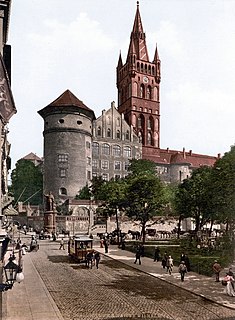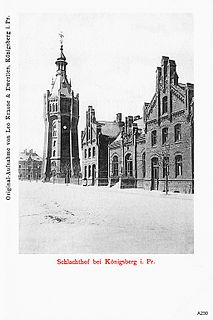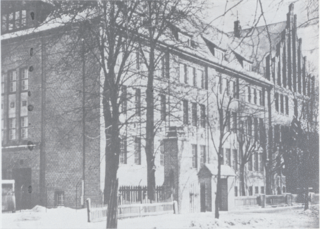History
Hufen's name was derived from the system of measurement Hufe , approximately 30 morgen. Under the control of Altstadt by 1286, [1] it was known as Huben by 1300. [2] It originally extended north and west from Steindamm Gate. By 1710 Altstadt had foresters tending to the Kaporner Heath northwest of Königsberg, living along the Alte Pillauer Landstraße on the road to Pillau. Rich Königsbergers began to visit the countryside in summertime. By the end of the 18th century Hufen consisted of the estate Ratshof and the villages Vorderhufen ("near Hufen") in the north, Mittelhufen ("middle Hufen") in the northwest, and Hinterhufen ("further Hufen"), later known as Amalienau. [3] Hardershof developed north of Mittelhufen in the early 19th century.
A morgen was a unit of measurement of land area in Germany, the Netherlands, Poland and the Dutch colonies, including South Africa and Taiwan. The size of a morgen varies from 1⁄2 to 2 1⁄2 acres, which equals approximately 0.2 to 1 hectare. It was also used in Old Prussia, in the Balkans, Norway and Denmark, where it was equal to about two-thirds of an acre (0.27 ha).

Altstadt was a quarter of central Königsberg, Germany. During the Middle Ages it was the most powerful of the three towns that composed the city of Königsberg, the others being Löbenicht and Kneiphof. Its territory is now part of Kaliningrad, Russia.

Baltiysk, before 1946 known by its German name Pillau, is a seaport town and the administrative center of Baltiysky District in Kaliningrad Oblast, Russia, located on the northern part of the Vistula Spit, on the shore of the Strait of Baltiysk separating the Vistula Lagoon from the Gdańsk Bay. Population: 32,697 (2010 Census); 33,252 (2002 Census); 27,070 (1989 Census).
In 1786 Theodor Gottlieb von Hippel the Elder established the Bohlenweg, a road allowing easier access to the estate Pojenter Hof (later the Luisenwahl Park). The Bohlenweg-Verein was an association of villa owners founded at the beginning of the 19th century.

Theodor Gottlieb von Hippel was a German satirical and humorous writer.
The theologian Ehregott Andreas Christoph Wasianski (July 3, 1755 - April 17, 1831), a friend and biographer of the great German philosopher Immanuel Kant, lived in what would become the Villa Hufenterrasse. In 1812 the Laufenhof manor was converted into the Villa Conradshof. Seven villas burned down in 1826.

Immanuel Kant was an influential German philosopher. In his doctrine of transcendental idealism, he argued that space, time and causation are mere sensibilities; "things-in-themselves" exist, but their nature is unknowable. In his view, the mind shapes and structures experience, with all human experience sharing certain structural features. He drew a parallel to the Copernican revolution in his proposition that worldly objects can be intuited a priori ('beforehand'), and that intuition is therefore independent from objective reality. Kant believed that reason is the source of morality, and that aesthetics arise from a faculty of disinterested judgment. Kant's views continue to have a major influence on contemporary philosophy, especially the fields of epistemology, ethics, political theory, and post-modern aesthetics.
Hufen was connected to Lawsken in 1829 by the construction of a chaussee . Hufen increasingly developed into residential suburbs for Königsberg's high society and financiers; notable buildings included Etablissement Conradshof, Park Villa Nova, Villa Hufenpark, Hufenterrasse, Villa Bella, the Konditorei Amende, Birkenhäuschen, Fortuna, Flora, Drachenfels, and Julchenthal. [2]
Lawsken was a suburban village and then quarter of Königsberg, Germany. Its territory is now part of the Tsentralny District of Kaliningrad, Russia.
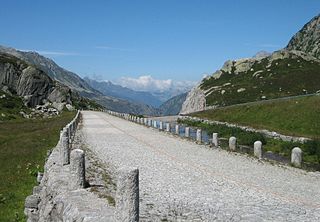
Chaussee is an historic term used in German-speaking countries for early, metalled, rural highways, designed by road engineers, as opposed to the hitherto, traditional, unpaved country roads. The term is no longer used in modern road construction in Western Europe, but survives in road names and is used by historians. In Eastern Europe and the post Soviet states it remains a generic term for a common paved highway outside of built-up areas, but they may transition into prospekts within towns and cities.
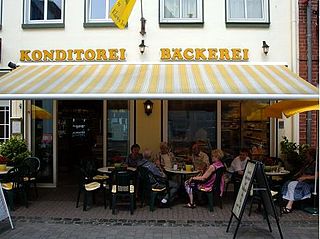
Akonditorei is a business that typically offers a wide variety of pastries and typically also serves as a café, these are found in many different countries including Germany, Austria, Switzerland, France, Denmark, Sweden, Czech Republic, and more. However the culture and function of the konditorei may vary based on locations. In Germany, Austria, and Switzerland it's a popular custom to go to a konditorei to have a cake and some coffee or hot chocolate mid-afternoon. A similar culture is present in several northern European countries influenced by central European trends, such as Denmark and Sweden. In order to become a konditor, the speciality baker for a konditorei, the profession requires an extensive apprenticeship or speciality training program.
Amalienau was incorporated into the city of Königsberg (Stadtkreis Königsberg i. Pr) piecemeal on 3 June 1898 and 1 April 1905. Vorderhufen and Mittelhufen were also merged into the city on the latter date. The main thoroughfare through Hufen was Hufen-Allee, which became Kniprodestraße in Steindamm and Neurossgarten at its eastern extremity and extended west to Königsberg's outer suburbs, such as Metgethen and Moditten. Hufen's streets were the first in Königsberg to be uniformly named, often honoring noted personalities from the city's history. [4] The Zahnärztliches Institut, a dental institute, opened on Alte Pillauer Landstraße in 1921 under the direction of Paul Adloff. [5]
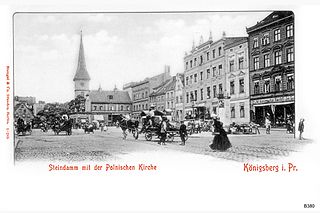
Steindamm was the oldest quarter of Königsberg, Germany. Its territory is now part of Kaliningrad, Russia.

Neurossgarten was a quarter of northwestern Königsberg, Germany. Its territory is now part of Kaliningrad, Russia.
Moditten was first a suburb of and then a quarter of Königsberg, Germany. Its territory is now part of the Tsentralny District in Kaliningrad, Russia.
While most of Königsberg was heavily damaged by the 1944 Bombing of Königsberg and the 1945 Battle of Königsberg, the quarters of Hufen were relatively unscathed by World War II and have been maintained in modern Kaliningrad.
This page is based on this
Wikipedia article Text is available under the
CC BY-SA 4.0 license; additional terms may apply.
Images, videos and audio are available under their respective licenses.
